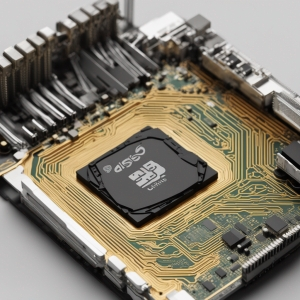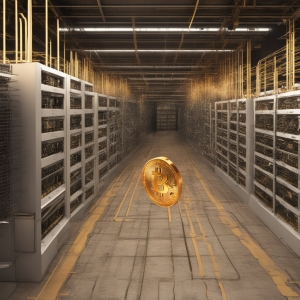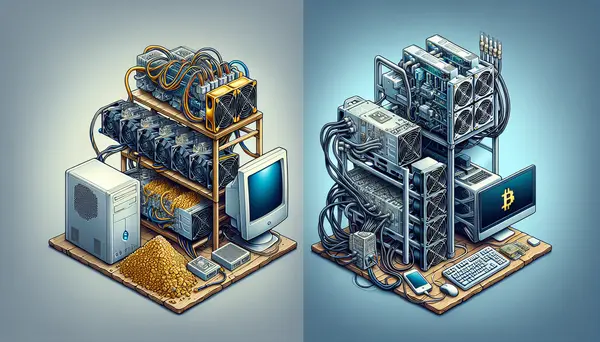Table of Contents:
Introduction: Understanding Bitcoin Mining
Bitcoin, the world's first and leading cryptocurrency, operates on a decentralized ledger system. Since its inception in 2009 by Satoshi Nakamoto, Bitcoin has utilized a shared decentralized database known as the blockchain, where transactions are legitimized cryptographically and processed through a peer-to-peer network. This groundbreaking digital asset has seen dramatic price fluctuations, reaching an all-time high in November 2021 of 68,744.03 USD.
New Bitcoin units are created through a process known as mining. This is where the term 'Bitcoin Mining' originates, and it contributes significantly to the Evolution of Bitcoin Mining. Notably, there is a limit of 21 million Bitcoins that can be mined, underlining the scarcity element of this digital asset. As technology has advanced, so has the process of Bitcoin mining, evolving from the use of Central Processing Units (CPUs) to specialized hardware known as ASICs.
Get $500 free Bitcoin mining for a free testing phase:
- Real daily rewards
- 1 full month of testing
- No strings attached
If you choose to buy after testing, you can keep your mining rewards and receive up to 20% bonus on top.
Bitcoin acceptance as a payment and investment tool has increased over the years. However, its decentralization of money creation, environmental impact due to high energy consumption, financial risks, as well as potential software bugs and attack scenarios have also attracted criticism. In this article, we delve into the evolution that has occurred within Bitcoin mining and how it impacts the broader cryptocurrency ecosystem.
The Dawn of Bitcoin Mining: CPU Era
Bitcoin mining started in the era of central processing units (CPUs), the hardware responsible for executing computing instructions. In the early days, anyone with a standard home computer could mine Bitcoin. The mining software was basic and user-friendly, allowing early miners to process Bitcoin transactions and combine several into a new block on the blockchain.
During this CPU era, mining was less about making a profit and more about supporting the burgeoning Bitcoin network. It was a testament to the decentralized ethos of Bitcoin - the network was kept operational by the collective efforts of its users.
However, as the network grew, so did the difficulty of mining. The hash rate, a measure of computing power used in mining, needed to increase to handle the growing number of transactions. This spurred the transition from CPUs to more advanced hardware, marking significant growth in the evolution of Bitcoin mining.
Pros and Cons of Bitcoin Mining Evolution
| Aspect | CPUs | ASICs |
|---|---|---|
| Cost | Low | High |
| Power Usage | High | Efficient |
| Speed | Slow | Fast |
| Difficulty of Setup | Easy | Hard |
| Profitability | Low | High |
The Graphic Processing Units (GPU) Phase

As the complexity of mining Bitcoin increased, miners started to leverage Graphic Processing Units (GPUs). Developed initially for rendering video games, GPUs were discovered to be far more efficient at performing the repetitive calculations necessary for Bitcoin mining. GPU mining considerably increased the network's hash rate, which in turn sped up the rate at which blocks were added to the blockchain, marking another important chapter in the evolution of Bitcoin mining.
Furthermore, GPUs could mine several Bitcoins daily, a significant improvement over CPUs. Mining farms started to appear, where multiple GPUs were assembled in one location, often in areas with cheap electricity to reduce operational costs. This signified a shift from individual mining to more industrialized operations.
However, despite their increased efficiency, GPUs were not designed with Bitcoin mining in mind. As such, they still consumed considerable power and generated substantial heat during operation. This resulted in the development of mining hardware specifically intended for Bitcoin mining – the introduction of Field Programmable Gate Arrays (FPGAs).
Field Programmable Gate Arrays (FPGA): A Gamechanger
The third stage of the evolution of Bitcoin mining came with the rise of Field Programmable Gate Arrays (FPGAs). These devices were the first truly dedicated mining hardware. FPGAs were programmable chips that could be tailored to efficiently perform the specific computations required for Bitcoin mining.
One of the key advantages of FPGAs was their lower energy consumption compared to GPUs. They provided a higher hash rate per unit of power, which helped to counter the increasing difficulty of mining and maintain profitability. This significant leap in efficiency continued the industrialization of Bitcoin mining, and more and more mining farms began to utilize FPGAs.
However, even with their improvements, FPGAs were about to be overshadowed by a new technology that was entirely designed for Bitcoin mining№Application-Specific Integrated Circuits (ASICs). This marked the current era in the evolution of Bitcoin mining.
The Rise of Application Specific Integrated Circuits (ASICs)

ASICs, or Application Specific Integrated Circuits, mark a significant milestone in the evolution of Bitcoin mining. These devices were developed specifically for Bitcoin mining, making them the most efficient and fastest mining hardware available to date. Unlike previous hardware used in mining such as CPUs, GPUs, and FPGAs, ASICs are not reprogrammable. The function of mining Bitcoin is embedded into the chip's architecture, giving them a competitive edge in terms of speed and energy consumption.
ASICs can process hash functions at a much faster rate than any other mining hardware, often computing billions of hashes per second. This sheer computing power comes with higher costs, not just in terms of the initial investment but also in terms of energy consumption. However, the sheer efficiencies they offer make them the preferred option for Bitcoin miners.
The emergence of ASICs has contributed to the professionalization and centralization of Bitcoin mining. Mining farms equipped with ASICs are often the only entities that can compete effectively in the Bitcoin network, as the barriers for entry have become too high for most individuals. ASICs have increased the overall security of the Bitcoin network, due to their high hash rates.
However, it should be noted that with the technological advancements of ASICs, controversy has arisen around the centralization measures they impose. Critics argue that ASICs diminish the decentralized ethos of Bitcoin by placing too much mining power in the hands of a few entities. Meanwhile, proponents argue that the efficiency and security contributions of ASICs ultimately benefit the entire Bitcoin network.
Conclusion: The Evolutionary Journey of Bitcoin Mining
In conclusion, the evolution of Bitcoin mining from the humble CPU to the specialized ASIC machines illustrates Bitcoin's growth in popularity and technological sophistication. This progression has seen Bitcoin transition from a hobbyist pursuit to a major industrial operation.
Whether you are an experienced miner or a novice in the crypto space, understanding the complexities and journey of Bitcoin mining is crucial. There is no predicting what the future holds for Bitcoin mining. However, the ever-increasing demand for Bitcoin and continuous advances in technology suggest that the world of Bitcoin mining will continue to evolve and transform.
ASICs Evolution and Bitcoin Mining Today

Today, ASICs represent the cutting edge of Bitcoin mining technology. They're not only customized for a single task, but they are also significantly more efficient than their predecessors. Able to compute trillions of hashes per second, an ASIC can outperform thousands of CPUs. This highly specialized hardware has resulted in an explosion in the network's total hash rate.
Furthermore, their lower power consumption compared to other hardware makes them a favourite among modern miners. This was a paradigm shift in the mining landscape, focusing efforts away from a wide variety of tasks towards one specific objective - Bitcoin mining.
ASIC mining farms, vast warehouses filled with thousands of machines working in tandem, are now common in regions with cheap electricity. Massive mining operations in places like China, Russia, and Kazakhstan play a significant role in processing transactions and ensuring the security of the blockchain.
However, the rise of ASICs has also invited criticisms. Many argue that it has led to the centralization of Bitcoin mining since only those who can afford these expensive machines can profitably mine. This has led to a gap between small-scale miners and large mining farms, marking a new challenge in the evolution of Bitcoin mining.
Conclusion: Reflecting on the Evolution of Bitcoin Mining
From humble CPUs to specialized ASICs, the evolution of Bitcoin mining has invariably reflected changes in technology and shifts in economic power. Today's miners are part of a complex ecosystem that employs cutting-edge technology, endures market volatility, and responds to regulatory shifts.
The story of Bitcoin mining evolution is not just about hardware evolution. It's about a continually evolving ecosystem that enhances the security and legitimacy of the decentralized digital economy. In many ways, the mining sector has become a crucial part of the financial and technological worlds. With energy efficiency and centralization as persistent issues, it's clear that the saga of Bitcoin mining evolution is far from over.
Whether you're a novice miner or a cryptocurrency enthusiast hoping to learn more, understanding how Bitcoin mining has evolved over the years can provide valuable insights into the workings and future of the digital currency market. After all, mining isn't just about making a profit; it's about being part of something that could change the world.
Effects of Evolving Mining Technology on the Bitcoin Ecosystem
As we trace the evolution of Bitcoin mining, it's essential to understand its broad impacts on the Bitcoin ecosystem. With the transition from CPUs to ASICs, mining has moved from being a hobby to a large scale, professional activity. This shift has influenced the distribution of mining power, and subsequently, the decentralization of the Bitcoin network.
Initially, when CPUs were king, the mining power was evenly distributed. This was because anyone with a computer could participate in mining, maintaining the decentralized nature of the Bitcoin network. However, as ASICs - significant investments - took over, mining became concentrated in the hands of those who could afford the required hardware and electricity costs. This, to some extent, has led to a centralization of the Bitcoin network, especially in regions with cheap electricity like China.
The evolution of Bitcoin mining has also made the network more secure. As mining operations have scaled, the computational power, or hash rate, of the network has increased exponentially. This makes it virtually impossible for a single entity to take over 51% of the network’s mining power, protecting the network from double-spend attacks.
However, the increase in mining has environmental ramifications. Bitcoin mining uses significant amounts of energy due to the computational power required. This has raised concerns surrounding the carbon footprint and the overall environmental impact of Bitcoin mining.
Overall, while the evolution of Bitcoin mining technology has brought about increased efficiency and security, it's also led to increased centralization and environmental concerns.
Conclusion: The Ongoing Evolution of Bitcoin Mining
The journey from the primitive era of CPUs to the modern age of ASICs marks a defining roadmap in the evolution of Bitcoin mining. It illustrates the continual drive for technological advancement within the Bitcoin network to keep up with its rapid expansion and associated complexities. While the ASICs era continues to dominate the Bitcoin mining landscape, the future undoubtedly holds new transformations.
Since its relatively obscure beginnings to its current global recognition, Bitcoin mining continues to evolve. The increase in hash rate, efficiency, and mining scale has been a testament to rapid technological advancements. The shift in mining hardware over the years, however, has also brought about notable changes in Bitcoin's decentralization goal.
Despite its evolutionary journey, Bitcoin mining remains a double-edged sword. On one side, it promotes a decentralized financial future free from governmental control. On the other, it poses significant environmental concerns and centralization issues. Hence, it becomes crucial to balance the technological advancements in Bitcoin mining with ethical and logistical considerations.
While the ASICs era is expected to continue, the future may bring even more efficient and cost-effective mining solutions, further contributing to the ongoing evolution of Bitcoin mining. As blockchain technology and cryptocurrencies continue to grow, so will Bitcoin mining. It's therefore an exciting time to be a part of this evolution and see where technology will take us next.
The Journey of Bitcoin Mining: Evolution Over the Years
What was the initial method of Bitcoin Mining?
Initially, during the early years of Bitcoin, mining was conducted on CPUs (Central Processing Units), the same processors that run most general-purpose computers.
What are GPUs and why did Bitcoin Miners start using them?
GPUs (Graphics Processing Units) are more effective for Bitcoin mining than CPUs due to their increased computational and multitasking capabilities. Miners, therefore, started using them to improve mining efficiency.
What led to the introduction of FPGAs in Bitcoin mining?
FPGAs (Field Programmable Gate Arrays) were introduced to increase the hash rates while reducing power consumption. This led to lower costs and higher profitability in Bitcoin mining.
Why have ASICs become the standard in Bitcoin mining?
ASICs (Application-Specific Integrated Circuits) are custom-built for particular uses, like Bitcoin mining. They offer far higher performance compared to CPUs and GPUs, making them the most efficient tool for mining Bitcoins.
What is the future of Bitcoin mining?
The future of Bitcoin mining lies in energy-efficient technologies and renewable sources of energy. Moreover, improvements in ASIC designs and the exploration of new consensus algorithms that reduce the need for computational power are expected to shape the future of Bitcoin mining.






